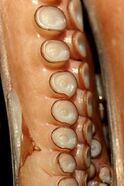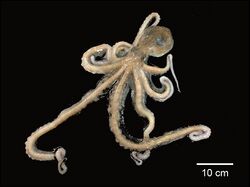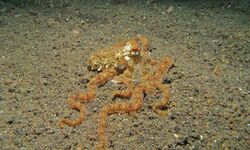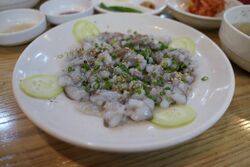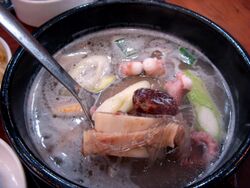Biology:Octopus minor
| Octopus minor | |
|---|---|
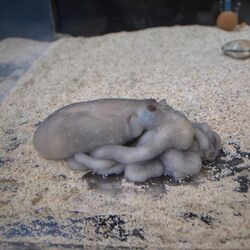
| |
| Scientific classification | |
| Domain: | Eukaryota |
| Kingdom: | Animalia |
| Phylum: | Mollusca |
| Class: | Cephalopoda |
| Order: | Octopoda |
| Family: | Octopodidae |
| Genus: | Octopus |
| Species: | O. minor
|
| Binomial name | |
| Octopus minor Sasaki, 1920
| |
| Synonyms | |
| |
Octopus minor, also known as the long arm octopus or the Korean common octopus, is a small-bodied octopus species distributed along the benthic coastal waters bordering China , Japan , and the Korean Peninsula. It lives at depths ranging from 0 to 200 metres (0 to 660 feet; 0 to 110 fathoms).[1][2] O. minor is commonly found in the mudflats of sub-tidal zones where it is exposed to significant environmental variation.[3] It is grouped within the class Cephalopoda along with squids and cuttlefish.[4]
O. minor carries cultural and economic value in the countries in which it is found. It is important commercially to the fishing communities in Korea, where it contributes to the $35 million octopus industry.[5] It is a Korean seafood, commonly referred to as nakji (낙지). The octopus is served both cooked and raw, and is often a snack during sporting events.[6]
There have been multiple findings concerning the physiological makeup of O. minor. It has been shown to host a dangerous parasite, while also demonstrating the ability to adapt its morphology to a wide range of environmental conditions. These characteristics have increased interest in the species and its genome has been mapped.[3][7]
Anatomy
The O. minor, similar to the rest of its order Octopoda, is bilaterally symmetrical along a dorsoventral axis with two eyes and mouth surrounded by eight webbed arms.[8] These arms contain two-thirds of the octopus's neurons.[9] On the underside of these arms, O. minor has "suckers" which are circular, adhesive suction cups. These are predominantly used for manipulation, navigation, and for preparing food.[8][9] O. minor has a bulbous mantle and visceral hump which contains the majority of its fundamental organs.[10]
O. minor is small and soft-bodied with long arms, hence its nickname “long-arm octopus”.[11]It can be identified by its grey colouring which matches the sandy plains in which it is commonly found, however when it finds itself threatened or in danger, it will shift its coloration to a dark red.[4]
Size
The O. minor reaches a mantle size of 18 centimetres (7 inches) with arms of up to 65 cm (25 1⁄2 in).[12] It is on the smaller side of its class, compared to colossal squids which can reach lengths of over 10 metres (33 feet).[13]
Distribution and behaviour
Feeding
O. minor, like other octopus populations, possesses predatory traits.[14] O. minor's diet coincides with that of other bottom-dwelling octopuses, with over 50% of its prey being fish, 25% by shellfish such as whelks and clams, the remainder being made up of crustaceans such as crabs, along with annelids and nematodes, other commonly found species sharing their habitat with O. minor.[15] The smaller size of the octopus means rejection of larger species including rock scallops and large fish.[14][15]
The benthic nature of O. minor allows it to move between rocks and through crevices.[15] Once it has identified its prey, it makes a sudden pounce, using its suckers to grip on and pull it in.[16] The O. minor preys on smaller animals by trapping them in the web-like structure of its legs.[14] The O. minor injects its prey with a paralyzing saliva, using miniature teeth at the end of its salivary papilla to dismember them.[14] When targeting shelled molluscs, the O. minor creates a toxic saliva that enables the calcium carbonate of the shell to be broken down.[15] Once the outer protection is penetrated, the prey's muscles relax, allowing the octopus to remove and eat its prey’s soft tissues.[14][15]
Feeding intensities differ between the males and females of the species.[15] Different intensities revolve around the ovarian maturation calendar of the female octopus.[15] From the months of April to July the intensity of feeding in females decreases, while in males it increases.[15] While 10 different taxa have been identified within the stomach of the O. minor, the Gobiidae family was most prevalent during the female's ovarian maturation.[15]
Locomotion
Different to other multi-limbed hydrostats such as crabs, the O. minor performs movements using all eight independent limbs.[17] The arrangement of muscles within its arms allows for movement in any direction.[18] Movements of the O. minor involve crawling between rocks and crevices, and swimming with its dorsal fin in a leading position.[18] Jet propulsion is another form of locomotion also used by the O. minor.[18] The process of crawling involves the use of the octopus's suckers.[19] Some are used to grip to surrounding environments allowing the octopus to pull itself forward with its legs. Others push from behind.[19] This process is repeated until a change of locomotion is performed.[19]
The O. minor performs a swimming motion using the expulsion of water from the mantle through its siphon into the ocean behind it.[18][20] Force provided by the water allows the octopus to move in the opposite direction.[20] The direction of movement is dependent on the way in which the siphon is faced. The long arms found on the O. minor provide it with a streamline swimming shape. Its bilateral symmetry allows it to move headfirst, with its legs trailing.[18][20] Jet swimming is used predominantly to escape from danger.[17]
The O. minor performs a movement known as “pumping”. This involves the legs of the O. minor contracting in unison, allowing for the production of a wave.[18] This provides a force which moves the body. The O. minor uses its appendages to crawl outside of the water.[21] For the O. minor this is performed between tide pools and when served as a culinary option.[21]
Habitat
The habitats of O. minor vary greatly between rocks, reefs and the ocean floor.[22] It is a benthic octopus, meaning it lies at the lowest body of water, around the sediment surface and rock or coral cover.[22] O. minor is located within the mudflats of sub-tidal zones surrounding the south western coast of the Korean peninsula.[4] O. minor residing within the mudflats of coastal regions are exposed to high salinity, temperature and water movement conditions.[3] The O. minor is found in rocky areas such as Jeju Island.[22]
The O. minor is commonly found in the Yellow Sea.[22] This is a segment of the Western Pacific Ocean situated between the Korean Peninsula and mainland China, connected to the Gulf of Bohai.[23] The sea extends over 950 kilometres from North to South and 700 kilometres wide.[23] The sea has a cyclone current and semidiurnal tides with temperatures that range from -10 degrees Celsius to 28 degrees Celsius.[23]
Colour change
The O. minor, when hunting and avoiding predators, use specialised pigment-filled bags known as chromatophores. These are found in the skin, allowing the octopus to adjust its color or reflectivity.[21] Colour variation of chromatophores include red, brown, black, grey, yellow or blue.[4] Other colour methods include the use of an iridescent dermal tissue.[21] This manipulated by the O. minor to communicate with other octopus and proceed with courtship rituals.[4]
The O. minor possesses muscles on its mantle which change texture to assist in changing colour.[4] The shallow water habitats which the O. minor inhabits has allowed it to evolve more diverse skin than fellow cephalopods.[4]
Relationship to humans
O. minor is well represented within the Korean commercial fishery field, presenting a high annual yield of over 350,000 tonnes.[3][24] This has led to its inclusion within multiple signature seafood dishes, mostly found in Korea.[25] The rapid adaption of the octopus to the stressful conditions of its habitat encouraged scientific research and the mapping of its genome.[26][3]
Culinary use
Within most parts of Korea, O. minor or Nakji, is a culinary option, being served most commonly as a snack either raw, cooked or poached.[25]
Nakji-bokkeum (cooked)
For this dish, O. minor is chopped, then stir-fried with vegetables such as carrots, onions and cabbage.[27] It is marinated with a local Korean red pepper sauce, then served hot with warm rice, somyeon, or bean sprouts.[27][6]
San-nakji (raw)
For this dish, O. minor is either chopped or whole and served raw on a plate. It is often served with sesame oil and sesame seeds.[28] The significant number of nerve endings in the arms of the O. Minor combined with its sophisticated nervous system, allows for a variety of movements when disconnected from the brain, meaning the octopus performs movements whilst being served.[28][29] As the suction cups are still active on the cephalopod's arms, they may grip to one's throat, therefore consumers are at risk of choking.[28]
Nakji-yeonpo-tang (soup)
For this dish, O. minor is boiled in stock, before being chopped into fine pieces then served in the soup with spring onion, chilli and minced garlic. The dish is traditionally offered during funeral processions.[30]
Dangers
A large percentage (22%) of O. minor have been found to host a dangerous parasitic benthic crustacean.[7] Their increased susceptibility is due to its lack of external shell compared to other molluscs, such as snails.[31] The presence Octopicola huanghaienis parasite is identified by a spike at the end of its labrum lap.[7] The parasite is a health concern when O. minor is served raw.[7]
Genetic research
O. minor's adaption of its behavioral repertoire to assorted habitat conditions made it a promising model to be studied and to have its genome mapped.[3] Distributions of the O. minor between the Korean Peninsula and Eastern China identified genetic differences in individuals from different habitats.[22] The borders of these countries are connected by the Yellow Sea. Genetic structures of O. minor were analysed using a sequence of the CO1 gene as it shows higher base-substitution mutation rates.[22]
Genome mapping
The morphology of the O. minor was analysed for genome mapping.[3] O. minor was studied for its ability to tolerate environmental changes. Its molecular basis was studied for plasticity development and mechanisms underlying adaption.[3] The concluding genome assembly of the octopus was 5.09 Gb, with over 30 010 genes; 44% were made up of repeated elements.[3][22] The total number of gene families within O. Minor are 178.[22] A highly identical nucleotide sequence across multiple species suggests the O. minor is actually the same species as Callioctopus ornatus and Callioctopus luteus, despite them occupying different habitats.[22]
References
- ↑ Lifeng, Li (March 2006). "Coastal Mollusks of the Yellow Sea Ecoregion and their habitats". https://www.wwf.or.jp/activities/data/200710y-seamap05e.pdf.
- ↑ "Editorial board". Marine Behaviour and Physiology 3 (3): ebi. January 1975. doi:10.1080/10236247509378505. ISSN 0091-181X.
- ↑ 3.0 3.1 3.2 3.3 3.4 3.5 3.6 3.7 3.8 Kim, Bo-Mi; Kang, Seunghyun; Ahn, Do-Hwan; Jung, Seung-Hyun; Rhee, Hwanseok; Yoo, Jong Su; Lee, Jong-Eun; Lee, SeungJae et al. (2018-09-25). "The genome of common long-arm octopus Octopus minor". GigaScience 7 (11). doi:10.1093/gigascience/giy119. ISSN 2047-217X. PMID 30256935.
- ↑ 4.0 4.1 4.2 4.3 4.4 4.5 4.6 Vendetti, J (2006). The Cephalopoda. https://ucmp.berkeley.edu/taxa/inverts/mollusca/cephalopoda.php.
- ↑ Glionna, J (2010). "South Korean fisherman, Health officials tangle over Octopus". https://www.latimes.com/archives/la-xpm-2010-oct-29-la-fg-korea-octopus-20101029-story.html.
- ↑ 6.0 6.1 Raskin, Hanna (2013-01-22). "Nakji bokkeum, the classic Korean octopus dish that's a stated specialty of" (in en-US). https://www.seattleweekly.com/food/nakji-bokkeum-the-classic-korean-octopus-dish-thats-a-stated-specialty-of/.
- ↑ 7.0 7.1 7.2 7.3 Du, Xin; Dong, Chao; Sun, Shi-Chun (2018-10-01). "Octopicola huanghaiensis n. sp. (Copepoda: Cyclopoida: Octopicolidae), a new parasitic copepod of the octopuses Amphioctopus fangsiao (d'Orbigny) and Octopus minor (Sasaki) (Octopoda: Octopodidae) in the Yellow Sea". Systematic Parasitology 95 (8–9): 905–912. doi:10.1007/s11230-018-9819-8. ISSN 0165-5752. PMID 30276653.
- ↑ 8.0 8.1 Invertebrate Zoology [Working Title]. 2020. doi:10.5772/intechopen.82957.
- ↑ 9.0 9.1 Wells, M. J. (1978). Octopus. doi:10.1007/978-94-017-2468-5. ISBN 978-94-017-2470-8.
- ↑ Glenister, Brian F. (1979), "Cephalopoda", Paleontology, Encyclopedia of Earth Science, pp. 170–183, doi:10.1007/3-540-31078-9_29, ISBN 0-87933-185-2
- ↑ El-Bawab, Fatma (2020), "Phylum Mollusca", Invertebrate Embryology and Reproduction (Elsevier): pp. 713–813, doi:10.1016/b978-0-12-814114-4.00011-4, ISBN 978-0-12-814114-4
- ↑ "Octopus bimaculoides Care Sheet (two-spot octopus)" (in en-US). https://tonmo.com/articles/octopus-bimaculoides-care-sheet-two-spot-octopus.6/.
- ↑ "Giant Squid | Smithsonian Ocean" (in en). http://ocean.si.edu/ocean-life/invertebrates/giant-squid.
- ↑ 14.0 14.1 14.2 14.3 14.4 A, Schmoldt; Hf, Benthe; G, Haberland (1975-09-01). "Digitoxin Metabolism by Rat Liver Microsomes" (in en). Biochemical Pharmacology 24 (17): 1639–41. doi:10.1016/0006-2952(75)90094-5. PMID 10. https://pubmed.ncbi.nlm.nih.gov/10/. Retrieved 2020-05-26.
- ↑ 15.0 15.1 15.2 15.3 15.4 15.5 15.6 15.7 15.8 Bo, Qi-Kang; Zheng, Xiao-Dong; Chen, Zhi-Wei (2020-01-27). Chapman, Maura (Gee) Geraldine. ed. "Feeding intensity and molecular prey identification of the common long-armed octopus, Octopus minor (Mollusca: Octopodidae) in the wild" (in en). PLOS ONE 15 (1): e0220482. doi:10.1371/journal.pone.0220482. ISSN 1932-6203. PMID 31986139. Bibcode: 2020PLoSO..1520482B.
- ↑ Jm, Stein (1975-09-15). "The Effect of Adrenaline and of Alpha- And Beta-Adrenergic Blocking Agents on ATP Concentration and on Incorporation of 32Pi Into ATP in Rat Fat Cells" (in en). Biochemical Pharmacology 24 (18): 1659–62. doi:10.1016/0006-2952(75)90002-7. PMID 12. https://pubmed.ncbi.nlm.nih.gov/12/. Retrieved 2020-05-26.
- ↑ 17.0 17.1 Taylor, Jennifer R. A.; Kier, William M. (April 2006). "A pneumo-hydrostatic skeleton in land crabs" (in en). Nature 440 (7087): 1005. doi:10.1038/4401005a. ISSN 0028-0836. PMID 16625186.
- ↑ 18.0 18.1 18.2 18.3 18.4 18.5 Huffard, C. L. (2006-10-01). "Locomotion by Abdopus aculeatus (Cephalopoda: Octopodidae): walking the line between primary and secondary defenses" (in en). Journal of Experimental Biology 209 (19): 3697–3707. doi:10.1242/jeb.02435. ISSN 0022-0949. PMID 16985187.
- ↑ 19.0 19.1 19.2 J, Järvisalo; Ne, Saris (1975-09-15). "Action of Propranolol on Mitochondrial Functions--Effects on Energized Ion Fluxes in the Presence of Valinomycin" (in en). Biochemical Pharmacology 24 (18): 1701–5. doi:10.1016/0006-2952(75)90009-x. PMID 13. https://pubmed.ncbi.nlm.nih.gov/13/. Retrieved 2020-05-26.
- ↑ 20.0 20.1 20.2 Kassim, I.; Phee, L.; Ng, W.S.; Feng Gong; Dario, P.; Mosse, C.A. (May 2006). "Locomotion techniques for robotic colonoscopy". IEEE Engineering in Medicine and Biology Magazine 25 (3): 49–56. doi:10.1109/MEMB.2006.1636351. ISSN 0739-5175. PMID 16764431.
- ↑ 21.0 21.1 21.2 21.3 Wood, James B.; Anderson, Roland C. (April 2004). "Interspecific Evaluation of Octopus Escape Behavior" (in en). Journal of Applied Animal Welfare Science 7 (2): 95–106. doi:10.1207/s15327604jaws0702_2. ISSN 1088-8705. PMID 15234886.
- ↑ 22.0 22.1 22.2 22.3 22.4 22.5 22.6 22.7 22.8 Kang, J.-H.; Park, J.-Y.; Choi, T.-J. (2012). "Genetic differentiation of octopuses from different habitats near the Korean Peninsula and eastern China based on analysis of the mDNA cytochrome C oxidase 1 gene". Genetics and Molecular Research 11 (4): 3988–3997. doi:10.4238/2012.november.21.2. ISSN 1676-5680. PMID 23212336.
- ↑ 23.0 23.1 23.2 Uda; Valencia (2020). "Yellow Sea". https://www.britannica.com/place/Yellow-Sea.
- ↑ "Octopus as Food - Octopus Facts and Information" (in en-US). https://octopusworlds.com/octopus-as-food/.
- ↑ 25.0 25.1 Jasti, Sunitha (2011). "Gender, Acculturation, Food Patterns, and Overweight in Korean Immigrants". American Journal of Health Behavior 35 (6): 734–45. doi:10.5993/ajhb.35.6.9. ISSN 1087-3244. PMID 22251764.
- ↑ Muhammad, Faiz; Dou, Canfeng; Lü, Zhen-ming; Gong, Li; Du, Xun; Shafi, Muhammad (2018). "Genetic Structure of Octopus minor (Sasaki, 1920) (Cephalopoda: Octopoda) from Chinese Waters using Mitochondrial ATPase 6 Gene". Pakistan Journal of Zoology 51 (1). doi:10.17582/journal.pjz/2019.51.1.sc5. ISSN 0030-9923.
- ↑ 27.0 27.1 Service (KOCIS), Korean Culture and Information. "Korean recipes: spicy stir-fried small octopus, nakji bokkeum (낙지볶음) : Korea.net : The official website of the Republic of Korea". http://www.korea.net/NewsFocus/Culture/view?articleId=132155.
- ↑ 28.0 28.1 28.2 "San-nakji live raw octopus". http://www.eatinkorea.com/en/food/sannakji-live-raw-octopus.
- ↑ June 2017, Alina Bradford-Live Science Contributor 08 (8 June 2017). "Octopus Facts" (in en). https://www.livescience.com/55478-octopus-facts.html.
- ↑ "Nakji Jeongol (Korean Octopus Stew)" (in en). 2016-07-05. https://thedomesticman.com/2016/07/05/nakji-jeongol-korean-octopus-stew/.
- ↑ Roumbedakis, Katina; Drábková, Marie; Tyml, Tomáš; di Cristo, Carlo (2018-11-20). "A Perspective Around Cephalopods and Their Parasites, and Suggestions on How to Increase Knowledge in the Field". Frontiers in Physiology 9: 1573. doi:10.3389/fphys.2018.01573. ISSN 1664-042X. PMID 30515100.
Wikidata ☰ Q76565 entry
 |
